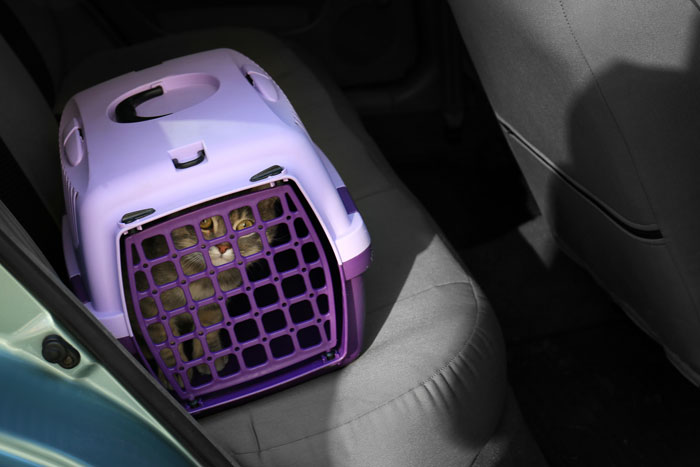Does your cat hate riding in the car? It might be because they get carsick.
I’ve never had a cat who got carsick, so I was surprised when a friend mentioned that her cat had awful carsickness, manifesting in a terrible case of diarrhea every time the cat had to ride in a vehicle.
It made me want to investigate further, so I went to a couple of experts for the inside scoop.
Cats and Cars
Most cats don’t ride in cars as frequently as dogs, and we all know that cats generally aren’t fond of new or unusual experiences. The fear, anxiety, and stress of riding in a vehicle in motion can trigger the nausea associated with motion sickness.
Amy Shojai, an IAABC-certified animal behavior consultant (cats and dogs), and Fear Free Certified Trainer says, “My own Karma-Kat doesn’t get car rides as often as he should but has rarely had problems with carsickness.” She adds that while Karma-Kat doesn’t have problems with short rides, longer trips flip the carsickness switch.
“We had to board him along with Shadow-Pup when called out of town for a funeral. The drive to the boarding facility takes about 45 minutes, and longer in traffic,” Shojai says. “Karma suffered carsickness about a half hour into the drive. He retched, drooled, meowed/complained, and ultimately vomited. The same thing happened when we picked him up for the drive home, so the length of the ride likely impacted Karma’s car-sickness reaction.”
Is It FAS (Fear, Anxiety, and Stress)?
“I’ve had lots of cats who arrived at my clinic having vomited in the carrier, including some who were known to vomit every single time they came to see me,” says Arnold Plotnick, DVM, a veterinary internist and former owner of Manhattan Cat Specialists, a feline-only veterinary hospital. “If they vomited and had diarrhea, well, that pretty much told me that it was anxiety.”
Many cats vomit when stressed, Shojai says, and a car ride ranks high on the feline stressor scale. “Cats don’t always get the same help getting used to car rides as dogs, and any change in routine may put kitty’s tail in a twist.”
Felines in Motion
When you put kitty in the car, the motion of the vehicle stimulates the area of the brain that triggers vomiting, says Shojai. The feeling of motion, but without seeing the car’s movement, can increase upset tummies, she adds.
“While dogs can stick their nose in the window crack to help with the feeling, cats must ride confined in carriers for safety and can’t see out. Cracking open the window can still help, with the rush of wind aiding the cat’s orientation with the movement of the car.”
Signs that can indicate carsickness:
- Loud meowing or howling
- Pacing or restlessness
- Excessive lip licking
- Excessive or unusual drooling
- Lethargy
- Vomiting
- Diarrhea
How You Can Help Kitty
Many cats dread the cat carrier because they associate it with the upcoming car ride. Shojai says the carrier is key to taking your cat in the car. “Part of it has to do with his acceptance of the carrier–he knows it as a safe place–and for short trips to and from the vet, he’s never had an issue. However, often cats learn to associate the carrier and car rides with scary trips that end at the vet with needle pokes and rude thermometers. It helps if the ride instead ends with fun stuff like a whipped cream treat at the coffee shop or a trip to grandma’s for cuddles.”
Some cats do better with the carrier covered, says Shojai. Withholding food prior to the car ride also can help. She says that ginger is a natural remedy for carsickness but not the best option for hard-to-pill cats.
If carsickness is an ongoing problem for your cat, medication can help, says Dr. Plotnick. “We used to give dramamine as a general treatment for motion sickness, but there are better, more effective options these days, such as gabapentin for nausea that results from anxiety or Cerenia, which is good for vomiting in general.” Dr. Plotnick says these can be given in advance of a car ride. Be aware that gabapentin and oral Cerenia are used off-label in cats, and talk to your veterinarian to make sure you understand what that means.
Carriers Are Key
“Ideally, teaching cats to accept carriers–and the car ride–works the best. Work to reduce stress and to associate the carrier AND the car with positive experiences,” Shojai says. “Make the carrier part of the furniture, turn it into a bed with ‘surprise’ treats inside for the cat to discover. Take your cat for rides in the car around the driveway or the block, and then home with a fun treat or toy reward when they get back.” This can help with FAS or carsickness.
This article was reviewed/edited by board-certified veterinary behaviorist Dr. Kenneth Martin and/or veterinary technician specialist in behavior Debbie Martin, LVT.
Sandra Toney has been writing about cats for over 25 years and is an award-winning member of Cat Writers Association and Dog Writers Association of America. She has written for many print and online magazines about cat health and behavior as well as authoring eight books. She lives in northern Indiana with her cat, Angel.
Photo credit: Shutterstock
Want to stay in the loop on the latest and greatest in keeping your pet happy and healthy? Sign up for our free newsletter by clicking here!








